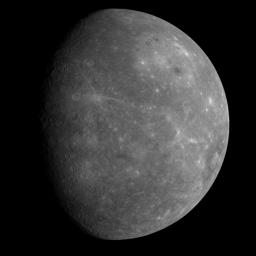
|
MESSENGER’s First Look at Mercury’s Previously Unseen Side
- Click the image above for a larger view
- Full-Res JPEG (1024 x 1024) (70.5 kB)
- Full-Res TIFF (1024 x 1024) (1.1 MB)
Caption:
When Mariner 10 flew past Mercury three times in 1974 and 1975, the same hemisphere was in sunlight during each encounter. As a consequence, Mariner 10 was able to image less than half the planet. Planetary scientists have wondered for more than 30 years about what spacecraft images might reveal about the hemisphere of Mercury that Mariner 10 never viewed. (See Mariner 10 images .)
On January 14, 2008, the MESSENGER spacecraft observed about half of the hemisphere missed by Mariner 10. This image was snapped by the Wide Angle Camera, part of the Mercury Dual Imaging System (MDIS) instrument, about 80 minutes after MESSENGER's closest approach to Mercury (2:04 pm EST), when the spacecraft was at a distance of about 27,000 kilometers (about 17,000 miles). The image shows features as small as 10 kilometers (6 miles) in size. This image was taken through a filter sensitive to light near the red end of the visible spectrum (750 nm), one of a sequence of images taken through each of MDIS's 11 filters.
Like the previously mapped portion of Mercury, this hemisphere appears heavily cratered. It also reveals some unique and distinctive features. On the upper right is the giant Caloris basin, including its western portions never before seen by spacecraft. Formed by the impact of a large asteroid or comet, Caloris is one of the largest, and perhaps one of the youngest, basins in the Solar System. The new image shows the complete basin interior and reveals that it is brighter than the surrounding regions and may therefore have a different composition. Darker smooth plains completely surround Caloris, and many unusual dark-rimmed craters are observed inside the basin. Several other multi-ringed basins are seen in this image for the first time. Prominent fault scarps (large ridges) lace the newly viewed region.
Other images obtained during the flyby will reveal surface features in color and in much more detail. Collectively, these images and measurements made by other MESSENGER instruments will soon provide a detailed global view of the surface of Mercury, yielding key information for understanding the formation and geologic history of the innermost planet.
Mission Elapsed Time (MET) of image: 108829708
Background Info:
These images are from MESSENGER, a NASA Discovery mission to conduct the first orbital study of the innermost planet, Mercury. For information regarding the use of images, see the MESSENGER image use policy .
Cataloging Keywords:
| Name | Value | Additional Values |
|---|---|---|
| Target | Mercury | |
| System | ||
| Target Type | Planet | |
| Mission | MESSENGER | Mariner |
| Instrument Host | MESSENGER | Mariner 10 |
| Host Type | Orbiter | Flyby Spacecraft |
| Instrument | Mercury Dual Imaging System (MDIS) | |
| Detector | ||
| Extra Keywords | Asteroid, Comet, Crater, Grayscale, Impact | |
| Acquisition Date | ||
| Release Date | 2008-01-15 | |
| Date in Caption | 2008-01-14 | |
| Image Credit | NASA/Johns Hopkins University Applied Physics Laboratory/Carnegie Institution of Washington | |
| Source | photojournal.jpl.nasa.gov/catalog/PIA10172 | |
| Identifier | PIA10172 | |
